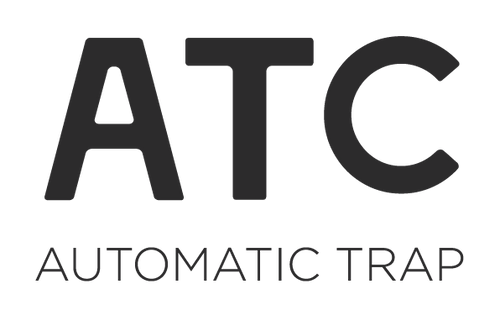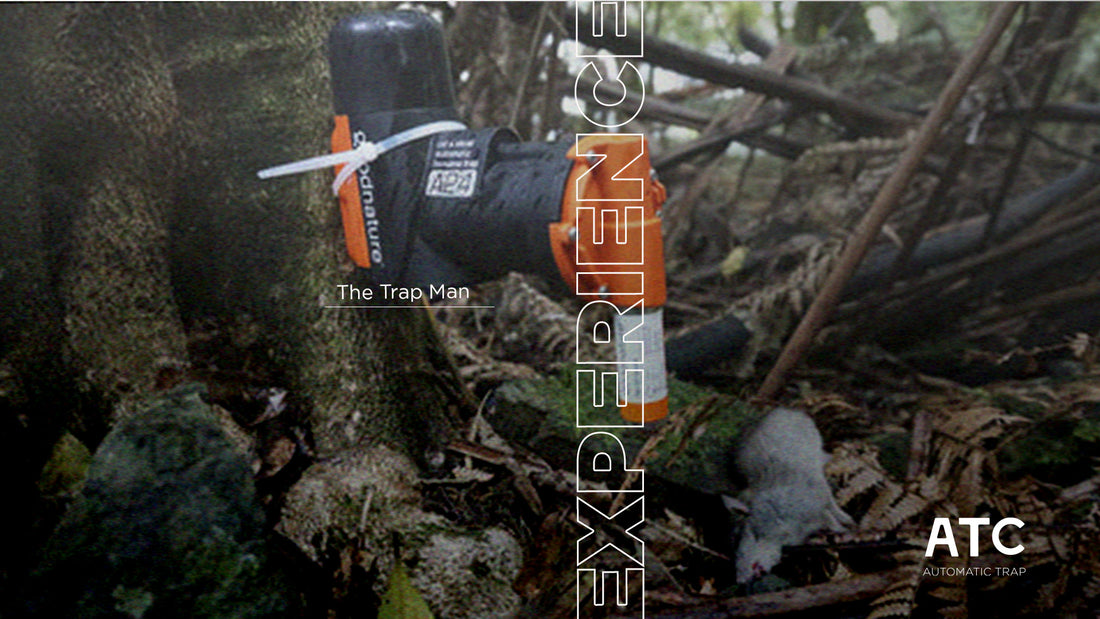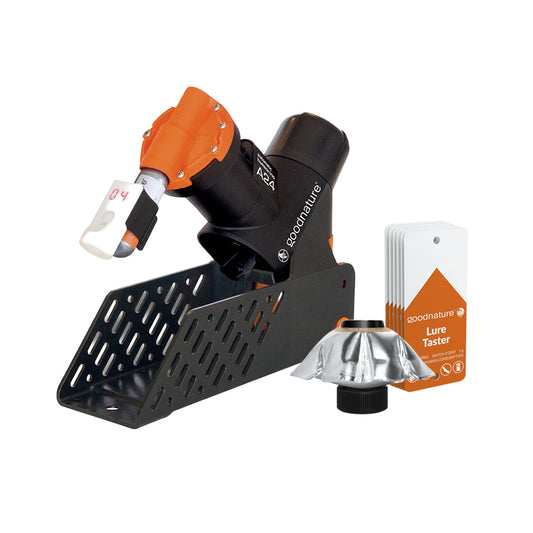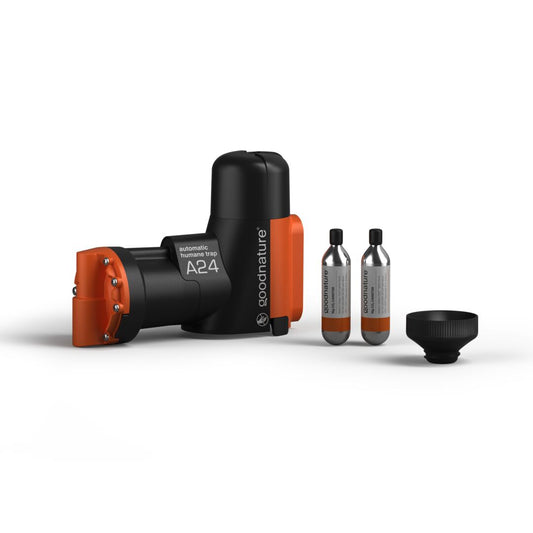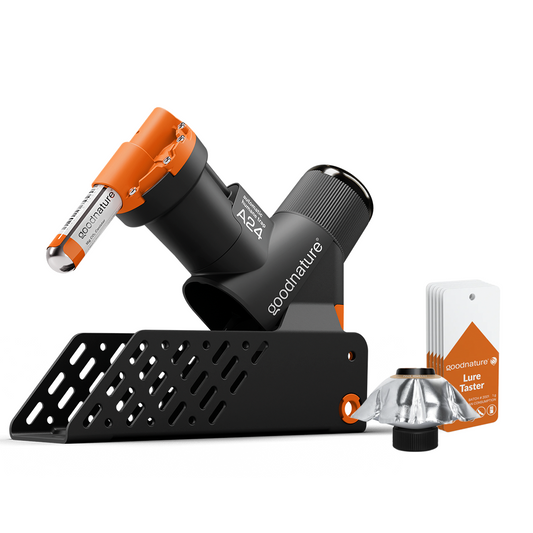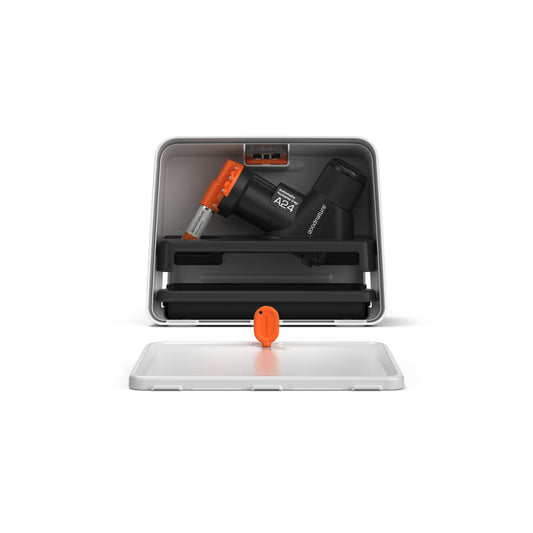
Our traps are used for much more than keeping rats and mice out of your home or property. Continue reading to find out how Sam The Trap Man uses the A24.
I started my career as a trapper at age 12 in Te Urewera, New Zealand, a land where your wealth is measured in horses and true bushmen were still commonplace. A land where being a tall, gangly, light-skinned young man meant I stuck out like a sore thumb. The local Tuhoe people (“children of the mist”) were in the most part short, stocky, and dark of skin. I stumbled into this world as the last light of an era flickered like a candle wick about to be engulfed in the dregs of melted wax. This was an era where being a bushman was a trade. Men would load up a line of short bush ponies with food, chainsaws, fuel, traps, pots, rifles and everything else they would need for a comfortable existence in the bush and disappear for months on end. Some still did not wear shoes and clothed themselves in long black woolen singlets, while others embraced the modern times of helicopters and polar fleece.
This is the world I walked into — a world where the traditionalists started their traplines in the dark at 4am — no breakfast, no lunch and no water taken with them. They were bushmen and the bush had everything they needed. It would feed them when they were hungry, they would stop at streams when a thirst grew inside of them and when they were sick they knew the plants that would help them become well once more.
In saying that I was part of a new generation — a generation that had brought helicopters to the bush, bought their food at a supermarket, and definitely took a packed lunch with them on the hill. I was young and impressionable and while they made sure to load me up with knee-buckling packs of traps, I relished my days spent learning from these traditional bushmen as we protected our native biodiversity. We were in a high paced transitional phase in the bush. We were still using fenn traps — a hangover from the English gamekeepers — but innovations were just around the corner.
In the evenings I would sit at the feet of the world's great conservation heroes such as Darren Peters and Lindsay Wilson as they debated conservation methodologies, sharpened thoughts on trapping techniques, and refined trap design. It was during these long evenings staring into the fire — them sipping on enamel mugs full of whiskey and me sipping on hot tea — that birthed the DOC series of traps and later the Goodnature A24
Four years into my career as a trapper I met Robbie Van Dam, a man from the Capital City. Darren had brought him into the bush to show him what we were doing. Robbie was a designer who was working for the Department of Conservation and Darren could see that he had an eye for making things work.
We needed a light trap that could make multiple kills before it had to be reset. In any given area of New Zealand bush, there is an abundance of rats and very few stoats due to stoats having a very large home range and rats having very small. The issue was that our old heavy single-action trap lines would quickly clog up with rats, not allowing them to be open and available to catch a stoat, and the stoats were the ones having big impacts on our native bird life.
That's why we needed Robbie. Up until that point we had relied on trappers to refine and design our traps. They built robust, sturdy traps with big metal springs that had the power and holding ability to crush any predator that interacted with it. Robbie, on the other hand, saw the opportunity to build just enough of a trap to house a killing mechanism. He would use just enough power to kill the target species humanely and he would use materials that would be incredibly light yet strong. What's more, he would figure out a way for this new generation of traps to kill up to 24 animals before it needed to be reset, allowing us to sift through the crowd of rats and still have the trap available to catch the all-important stoat.
The Department of Conservation’s solution up until this point was to replace trapping and trappers with toxins, sometimes aerially deployed from helicopters. As a young bushman who now ate and drank from the bush and had taken on many of our traditional mindsets, this was not an agreeable solution.
I was not to run into Robbie again for many years. I would hear the odd update through the bush grapevine about the inventions he was working on in Wellington while I continued to hone my skills as a trapper. It wasn’t until much later that I would bump into him and by this time he —along with his good friends and business partners Craig and Stu — had brought the Goodnature A24 to market.
My first experience using Goodnature A24’s was in Fiordland. At the time we were using heavy traditional DOC200 wooden box traps to control stoats and toxicants to control rats across large landscapes. Goodnature and the Department of Conservation wanted to do a field trial across 300ha to see if A24’s could suppress rat numbers better than other toxin methodologies in a beech mast year and what's more they wanted me to run it.
If you're involved in New Zealand conservation, this is the biggest test a tool can face — short of complete eradication of an introduced predator. We would be measuring the traps performance against an aerially deployed toxin called 1080 and a hand-laid toxin called pindone in bait stations. The idea was to see what method held rats to the lowest levels during a significant beech mast, and we would monitor the results with tracking tunnels.
The results were conclusive. The Goodnature A24s held rats at less than 5% rat-tracking rate, while the other methodologies came in at around 14-20% each. Next, we decided to up the stakes and remove every second trap, halving the density and doubling the size of the block. Once again the A24’s outperformed the toxic methodologies, achieving less than 5% rat tracking with a much higher percentage for both toxic methods.
For me, this was mind blowing! As a trapper, I knew I had carefully tweaked each set until I was proud of it. I had given these new traps the best shot I could to succeed, but I hadn't actually expected them to work. In true New Zealand culture, we treat anything new with a fair amount of suspicion and these traps definitely did look like something a coffee drinker from the city had dreamt up, compared to the rough wooden boxes we were used to using. But these traps had gotten the result and not only that, but they outperformed the most efficient methods we had for controlling rats at that time.

Up until the A24, my life consisted of carrying two 12kg wooden trap boxes at a time through the Fiordland Mountains, and lugging 25kg sacks of poison up steep sided glacial valleys to fill bait stations. With these new traps, I could now fit 30 in a pack instead of two, and there was no need to worry about the respirators, gloves, etc. that come when working with toxins.
It was during this scientific trial too, that I stumbled across the key that would unlock the way I viewed trapping for the rest of my life. As I walked my lines servicing traps, I found that we had caught a stoat and on closer inspection, I saw that not only had we caught one stoat but we had actually nailed an entire family group under one trap. Two traps further down the line, I caught another. This meant that not only did the A24 work for stoats, but it worked better than any other trap available to us at the time.
Stoats are incredible in the way they teach their young to hunt. They learn through imitation and inquisitiveness. We had evolved traditional trapping methods to include a double set of single action traps and would often catch a mother and a juvenile in the same trap box, but here we caught a mother and her three kits in the same trap, and two traps over we had caught the male. This was likely to be the entire stoat population for km’s around, and now the Kiwi and Whio population in the area would be safe.
After a few years working with A24’s in Fiordland and then managing a wildlife sanctuary in the North Island of New Zealand, I was ready for a bit of a change. I was worn out. For the first time, a hot shower every night and a comfy bed — not digging through snow to rebait traps in winter and being baked by the sun in summer — seemed appealing.
It was at this time that Goodnature saw fit to put me on salary as their Technical Expert. I guess they figured that aside from Robbie and Darren, no one else had more experience with Goodnature A24’s in a wide range of habitats, so they gave me a job. It was my role to travel around the country helping people establish large conservation projects using A24’s. I would design the project with people, help them lay it out, and ensure they got the results they were after.
It was a great gig that had me in a helicopter or out on boats most weeks. I was in the bush doing what I did best — tweaking project designs and optimizing trap sets. A lot of the time I was training new trappers or helping old trappers wrap their minds around new methodologies. We learned a lot during this time, particularly about staying open minded to a variety of lures and continuing to work on the trap so it could be the best product we could offer in the field.
Goodnature A24s are out there killing predators and protecting native birds while you're warm and cozy at home. In that way, the A24 is the trappers' trap.
The biggest hurdle we faced was old-school trappers wanting to see something dead in their traps. When in reality, the rats and stoats just fall out the bottom and get scavenged by other rats and stoats. I tried to get their minds around the fact that because you don't see a dead animal doesn't mean the trap hasn’t caught something, but trappers are trappers and they still like to see something dead. In the end, I ended up comparing the Goodnature A24 to a “non-toxic” bait station. With poison, we don't expect to see a dead animal, we just know it’s worked. So why don’t we think about the Goodnature A24 in the same way? It’s just a better non-toxic version.

After three years on the road and helping set up a stack of conservation projects, it was time to spend more time at home. I had just become a family man with the arrival of my son and traipsing across the country wasn’t exactly how my wife thought our existence should be, so I stepped away from Goodnature and took up a role as a Land Support Officer for NZ Landcare Trust, I was tasked with supporting landowners to increase their on-farm biodiversity and water quality. This is how Eastern Whio Link was born.
I quickly found out that farmers in New Zealand are time poor and cash poor so asking them to do any amount of biodiversity work was going to be difficult. Instead, I took a leaf out of what I had seen in America. I enlisted the help of my hunting mates. In America, I had noticed that hunters often do improvement work on properties in exchange for hunting access. We as hunters naturally care about the areas we hunt, so are more than happy to give a couple of weekends a year to look after these places.
So in 2020, we established our first 250 Goodnature A24’s around an almost locally-extinct Whio population (the Whio are our native blue duck — one of just three torrent ducks in the world and at serious risk from stoat predation). We had just 4 pairs of Whio left in the river we were trapping and in the first year, we managed to kill enough stoats so that these Whio fledged 20 ducklings.
I had grown up in these rivers hunting and fishing so I knew the country well. These streams used to be abundant with our native Blue Duck and we would often see them as we stalked rainbow trout and snuck in on red deer. With these 20 ducklings entering the population, it was great to once again see them more frequently.
On hearing about our success, the hunting industry as well as the New Zealand Government, got behind the project and allowed us to increase our trap numbers to 900 across 40,000ha of New Zealand bush and backcountry farms. In the second year, we managed to fledge another 26 Whio chicks and the results just keep coming.
Now there are hunter-led groups across the country who are setting up their own projects protecting Whio and Kiwi the way we are. They are using the same methodologies and the things I learned while working for Goodnature and implementing them in their situations.

The way I see it, the A24 is a great tool for work in the backcountry. It's light and intuitive to use. I have young kids right through to our 70-year-old hunters checking trap lines in the bush and the fact that they only need to be checked 2-3 times a year means we can choose the days we want to be out there. There's nothing quite like lying in bed at night with rain pouring on the roof, the rivers flooded and the roads closed, knowing our Goodnature A24s are out there killing predators and protecting native birds while you're warm and cozy at home. In that way, the A24 is the trappers’ trap.
There are always going to be those traditionalists that like to see a dead animal in their trap. I see that as a hangover from the fur trapping days. There are always going to be those that swear there is no other way than poisons, but to me if the technology is there, why not use it. In reality, the A24 is the realization of trappers' wish list — that same wish list we laid out to Robbie in Te Urewera all those years ago, and he and the team at Goodnature have delivered that tool.
They say you don't look a gift horse in the mouth. I'm not sure exactly what that means, but I reckon it has something to do with using the best tools you have in front of you at the time and for me when it comes to stoats and rats, the A24 is that tool.
